Even though the COVID-19 pandemic posed challenges for healthcare and life sciences companies, Canada’s pharmaceutical industry continued to thrive, thanks to the government’s investments in pharma which buttressed the industry against the storm. Comprising a 2.1% share of the global pharmaceutical market, Canada now ranks as the 9th largest market worldwide. There’s no resting on its laurels as the Canadian market continues to experience steady growth with the expectation of hitting USD 39,427.4 million by 2028, at a CAGR of 5.26%. The reason?
Brain Power
With 59.4 percent of Canadians aged 25-64 holding tertiary education degrees, Canada ranks as the most highly educated country globally. Of these graduates, over 4.8 million have STEM or healthcare degrees, providing a wealth of expertise for the pharmaceutical sector. The country has experienced a positive trend in STEM graduates, with a 51 percent increase in STEM graduates between 2010 and 2018, totaling more than 2.8 million STEM graduates in Canada’s labor force. This makes the country an attractive destination for life sciences companies.
Canada also offers an innovative environment for life sciences ventures, particularly in provinces such as Québec and Ontario. The Québec City-Windsor corridor, the second-largest life sciences cluster in North America, exemplifies the country’s strengths in innovation, talent, collaboration, and industry clusters. This corridor encompasses approximately 1,100 organizations and 490 graduate and undergraduate programs in biological and biomedicine sciences. Montreal, for instance, leads healthcare innovation with its expertise in artificial intelligence, while Toronto boasts a concentration of hospitals, research institutes, business incubators, and venture capital organizations. This collaborative ecosystem fosters innovation, further propelling Canada’s position in the pharmaceutical industry.
As such, the sector plays a significant role in international trade, with pharmaceutical exports and imports between Canada and the rest of the world experiencing substantial growth in recent years. The United States is Canada’s main trading partner, accounting for a significant portion of both exports and imports. Therefore it isn’t surprising that pharmaceuticals constitute a significant portion of Canada’s health care spend representing 15% of total expenditures. What are some of the main drivers of this trend?
Canadian Unmet Needs
The geriatric population is more susceptible to metabolic and lifestyle disorders, cognitive impairment, and other conditions, leading to a higher demand for medications. Additionally, the prevalence of chronic diseases like hypertension, diabetes, arthritis, and asthma among Canadians is on the rise, further driving the pharmaceutical market. The over-the-counter (OTC) drugs segment is also expected to witness strong growth, as it has been influenced by the COVID-19 pandemic and the increasing prevalence of topical disorders and skin diseases such as atopic dermatitis and melanoma.
Leading this growth is the unfortunate statistic that approximately 1 in 12 Canadians suffer from 1 of over 7,000 different rare diseases, and the number of rare diseases identified increases every week especially with the emergence of personalized medicine. These rare diseases which include angiosarcoma, Fabry’s Disease and endometrial cancer, are treated with specialty pharmaceuticals which even though only made up fewer than one percent of Canadian claims in 2021, cost nearly 64 times more per claim than their non- specialty counterparts. What are theses drugs?
Specialty Pharmaceuticals
Specialty pharmaceuticals are a distinct category of drugs that differ from traditional medications due to their unique characteristics and requirements. These medications often necessitate intensive clinical monitoring to manage severe side effects, frequent adjustments in dosage, and specialized training for handling and administration. Specialty pharmaceuticals can be large, injectable, protein-based molecules produced through biotechnology processes, or they may be small molecules manufactured using traditional pharmaceutical methods.
Early specialty pharmacy products focused on treating complex conditions affecting smaller, distinct disease populations such as multiple sclerosis, cancer, pulmonary hypertension, hemophilia, and hepatitis C. While newer specialty pharmaceuticals continue to be developed for smaller populations, many recent products target larger, more common chronic diseases that require ongoing maintenance therapy, like rheumatoid arthritis and asthma. The defining characteristic of specialty pharmaceuticals is that they demand more attention and management due to their high cost, complex administration procedures, and the need for intensive monitoring.
The cost of specialty pharmaceuticals can be significant, ranging from $10,000 to over $7,000,000 per patient per year. In addition to the drug itself, there are other associated expenses such as drug distribution, specialized laboratory testing, and adjuncts to therapy and nursing services. Unlike traditional medications, specialty pharmaceuticals often lack competing or generic alternatives due to their unique attributes, complex production methods, and patent protection. Some manufacturers may restrict the distribution of their drugs to specific pharmacies based on production capacity, target patient populations, or the need for close patient monitoring. As a result, these drugs may not be readily available through traditional community or mail service pharmacies.
Administration of specialty pharmaceuticals requires expertise, as they are predominantly administered through injections rather than conventional oral or topical forms. Many specialty pharmaceuticals cannot be self-administered and require special handling conditions, such as refrigeration or sterile environments for dose mixing. Furthermore, the use of specialty pharmaceuticals often involves intense monitoring to manage potential severe drug reactions, conduct high-tech diagnostics or tests to assess treatment outcomes, and monitor for adverse side effects. Given the high costs associated with these therapies, ongoing monitoring is crucial to optimize patient response and minimize excessive resource utilization.
Overall, specialty pharmaceuticals represent a unique class of drugs that require specialized attention, management, and expertise due to their complex nature, high costs, and specific administration requirements. The development of specialty pharmaceuticals continues to address the needs of patients with complex conditions, offering targeted treatments and improved outcomes, albeit with distinct challenges for healthcare providers, payors, and patients alike.
Specialty Pharma Players
Medexus Pharmaceuticals (MDP.T) is an emerging player in Canada’s specialty pharmaceutical sector, making significant progress and achieving positive results despite market headwinds. The company has demonstrated consistent growth and revenue generation, with a strong focus on driving profitability and creating shareholder value.
According to Ken d’Entremont, the CEO of Medexus Pharmaceuticals, the company reported approximately $77 million in revenue in the previous year, and they expect this figure to reach between $107 million and $108 million in the current year. This represents a substantial year-over-year growth and highlights the success of their commercialization efforts. The company has also achieved positive EBITDA numbers, with around $5 million of positive EBITDA on $27-28 million of revenue.
Medexus Pharmaceuticals has implemented a strategic business model that leverages its existing infrastructure and commercial capabilities to partner with other companies and bring their approved medications to the market. This approach allows Medexus to expand its product portfolio without significant additional costs or resource requirements. The company’s strong revenue growth, consistent profitability, and ongoing search for new opportunities have positioned it as an attractive partner for pharmaceutical companies looking to enter the Canadian market.
Despite these positive developments, Medexus’s market capitalization remains relatively small compared to its annual revenue. With a market cap of around $29 million, which is just a quarter of its annual revenue, the company believes there is significant potential for appreciation in its share price as the market recognizes its consistent and durable financial performance.
While the Canadian healthcare investor pool may be limited, Medexus is focused on communicating its simple and effective business model to investors. By emphasizing its strong revenue growth, consistent profitability, and efficient infrastructure, the company aims to attract investors who understand the value proposition and growth potential in the specialty pharmaceutical sector.
Overall, Medexus Pharmaceuticals is emerging as a strong participant in Canada’s specialty pharmaceutical sector, with a track record of revenue growth, profitability, and successful commercialization efforts. The company’s strategic approach to product acquisition and its ability to leverage its existing infrastructure position it for continued success in the future. As the market recognizes the company’s consistent performance and appreciates its potential, Medexus Pharmaceuticals is ready to capitalize on further market recognition and increased shareholder value.
Overall, Canada’s pharmaceutical industry, with its focus on specialty pharmaceuticals and the emerging presence of companies like Medexus Pharmaceuticals, offers a compelling investment opportunity. The industry’s growth prospects, driven by the increasing demand for specialty pharmaceuticals, the country’s educated workforce, and its collaborative and innovative environment, make it an attractive long-term option for investors seeking exposure to the pharmaceutical sector.







